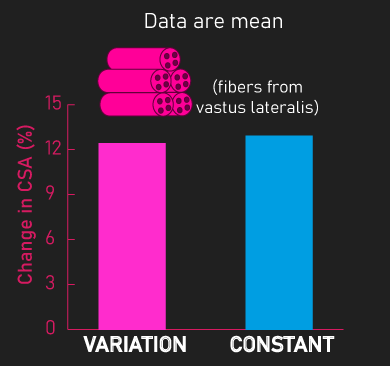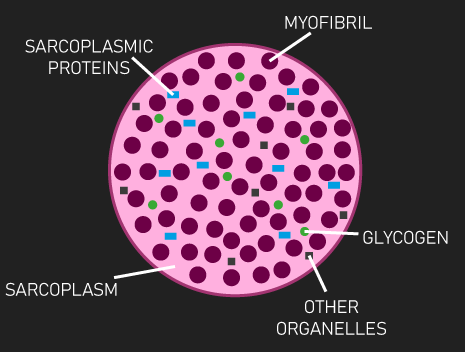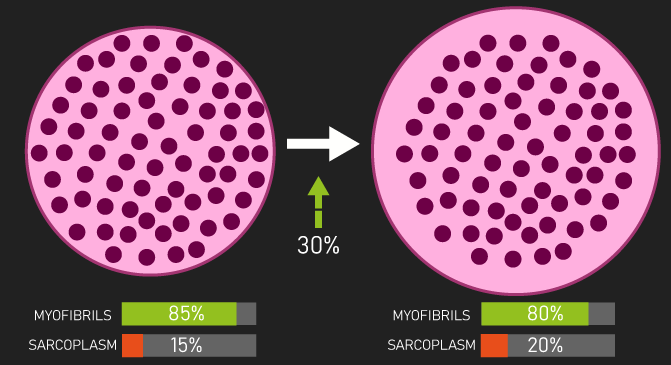
There are probably an infinite number of ways to train for hypertrophy.
Broadly, most people seem to perform the same weekly workouts, at least for a few months.
But, alternatively, an individual could randomly change their training variables across workouts.
In one session you may perform more sets on your exercises than usual, the next session you may use a different rep range, the session after this you change your rest interval durations between sets, and so forth.
The common justification behind frequently changing training variables relates to confusing or shocking the muscle.
The idea is usually presented as follows: your muscles very quickly adapt to a given stimulus, meaning training with the same routine week after week makes a plateau inevitable. To avoid this, frequency changing training variables is necessary to keep your muscles guessing and exposed to the unknown.
This idea is described in many articles online.
Even bodybuilders, such as Arnold, can be found discussing this:
So, does frequently changing training variables stimulate more muscle hypertrophy?
New Study on Changing Training Variables
A new study by Fox et al. gives us an insight.
The researchers reported their results across 2 different papers (one and two). So when discussing the results later, I would have pulled these results from the two different papers.
Subjects
20 men with an average age of 26, with an average of 2.5 years of training experience, were recruited.
Protocol
Each subject had one leg assigned to a variation condition, and their other leg assigned to a constant condition.
Subjects trained both legs twice per week for a total of 8 weeks.
With the leg assigned to the constant condition, each training session, they performed 4 sets of 9-12 repetitions to failure on the unilateral leg press, and 4 sets of 9-12 repetitions to failure on the unilateral leg extension.
They rested 2 minutes between sets, and loads were adjusted each set and over sessions to ensure 9-12 repetitions to failure were performed.
With the leg assigned to the variation condition, each session, subjects performed either one of 4 different training protocols in a randomized and balanced fashion:
The first training protocol varied repetition numbers. It had subjects perform 4 sets of 25-30 repetitions to failure on the unilateral leg press, and 4 sets of 25-30 repetitions to failure on the unilateral leg extension. 2 minutes of rest between sets was used.
The second training protocol varied set numbers. It had subjects perform 8 sets of 9-12 repetitions to failure on the unilateral leg press, and 8 sets of 9-12 repetitions to failure on the unilateral leg extension. 2 minutes of rest between sets was used.
The third training protocol varied contraction type. More precisely, it had subjects perform 4 sets of 10 eccentric contractions on the leg press and 4 sets of 10 eccentric contractions on the leg extension. The load used to perform these eccentric contractions was 110% of the load they would have used during normal repetitions. 2 minutes of rest was also used between sets in this session.
The fourth and final training protocol varied rest interval duration. It had subjects perform 4 sets of 9-12 repetitions to failure on the leg press and 4 sets of 9-12 repetitions to failure on the leg extension, with 4 minutes of rest between sets.
In all these training protocols, loads were adjusted each set to ensure subjects performed the repetition range given to them for that particular training protocol.
So, just to restate and make everything clear, the constant condition used the same training variables every session, while the variation condition did not.
Rather, the variation condition involved performing either one of four different training protocols in a session in a randomized and balanced fashion.
Findings
After the 8 weeks of training, vastus lateralis cross-sectional area increased similarly between both the variation and constant conditions.

Increases in cross-sectional area of muscle fibers obtained from the vastus lateralis were also similar between both the variation and constant conditions.

The researchers also measured an array of things within the muscle fibers obtained from the vastus lateralis.
Perhaps the most interesting thing they found was how the two different training conditions impacted the space taken up by myofibrils within the muscle fibers.
Before detailing what was found, it’s worth ensuring we understand what myofibrils are as well as the rest of what makes up muscle fibers.
Within muscle fibers are myofibrils. Myofibrils consist of an array of units called sarcomeres. Sarcomeres are what generate force. That is, they are what generates a muscle’s force.
Everything aside from the myofibrils within the muscle fiber can be considered the sarcoplasm. The sarcoplasm is largely water, but within it also resides components like glycogen, sarcoplasmic proteins, and other non-contractile organelles.

Returning to the study’s findings, before the training intervention, the muscle fibers from the vastus lateralis were comprised of around 70% myofibrils.
By the end of the training intervention, the constant condition still had roughly 70% of their vastus lateralis fibers comprised of myofibrils.
However, the variation condition’s vastus lateralis muscle fibers now only contained 61% myofibrils.
What does this mean?
Recall that both conditions experienced similar increases in cross-sectional area of muscle fibers obtained from the vastus lateralis. That is, muscle fiber hypertrophy was similar.
Given the constant condition saw no change in the relative space taken up by the myofibrils (it remained at roughly 70%), muscle fiber hypertrophy was achieved via proportion growth of the myofibrils and sarcoplasm. In other words, the myofibrils and sarcoplasm grew at the same pace, resulting in the myofibrils still occupying the same relative space (again, 70%) of the muscle fiber.
This type of muscle fiber hypertrophy, where the myofibrils and sarcoplasm both grow at the same pace, can be called “conventional” or “myofibrillar” hypertrophy.

Contrasting to this, given the variation condition saw a decrease in the relative space taken up by the myofibrils (from roughly 70% to 61%), muscle fiber hypertrophy for this condition would have been achieved via the sarcoplasm growing relatively more than the myofibrils, resulting in the myofibrils now taking up less relative space.

This type of muscle fiber hypertrophy, where the sarcoplasm grows relatively more than the myofibrils, can be called “sarcoplasmic” hypertrophy.
As a side note, sarcoplasmic hypertrophy does not mean the myofibrils decreased in size. Rather, they might have grown to some degree, or they may not have grown at all. The key point with sarcoplasmic hypertrophy is just the sarcoplasm grew relatively more than the myofibrils, which is why the percentage of space occupied by the myofibrils decreases.
Before moving on, if you’re curious about creating an effective training program for muscle hypertrophy, our high quality partner Alpha Progression can help. It can generate a highly effective program for you, track your workouts live with in-built progression recommendations, provide graphs displaying your long term progress, and it has a massive exercise database with more than 550 exercises.
Click HERE (the link opens in a new tab) to get a free 2 week trial of the apps features. If you like it and go beyond, the link also gives you 20% off a subscription!
We never promote trash at the House of Hypertrophy, so rest assured the app is high quality. The reviews speak to this, 4.8 starts (based on more than 7,000 reviews) on Google play, and 4.9 stars in Apple’s store (based on nearly 400 ratings).
Discussion
To summarize the key findings of the study, frequently changing training variables does not produce more hypertrophy versus training with the same routine, but it is not any worse either.
Therefore, this study does not support the notions of muscle confusion or shocking.
Intriguingly, despite similar magnitudes of hypertrophy, the type of hypertrophy at the muscle fiber level seemed to differ between conditions.
Frequently manipulating training variables appeared to produce sarcoplasmic hypertrophy, while maintaining the same training variables appeared to produce myofibrillar hypertrophy (also called conventional hypertrophy).
Why would this be the case?
Currently, it’s not clear whatsoever. The research on what occurs within muscle fibers is very much in its infancy, and it’s very difficult to scientifically pinpoint why certain training methods would cause sarcoplasmic hypertrophy or myofibrillar hypertrophy.
But allow me to share one speculation.
Myofibrillar hypertrophy, as it involves proportional growth of the myofibrils and sarcoplasm, would most likely be quite beneficial for strength, as remember, the myofibrils are what generate force. Perhaps training with a constant routine and overloading by progressing load (which is what the constant condition more or less involved) is conducive towards this type of hypertrophy.
Conversely, the variation condition actually ended up accumulating more volume load (the product of sets x reps x load) by the end of this study. Perhaps this, the fact it involved more work, was more conductive towards sarcoplasmic hypertrophy. I speculate this is as although it’s far from clear what drives the disproportionate sarcoplasm growth relative to myofibril growth (which we know is what sarcoplasmic hypertrophy is), it’s possible an increase in energy generating components within the muscle fiber could be involved.
I should again note this is purely speculation. As noted earlier, the researchers did measure an array of things within the muscle fibers obtained from the vastus lateralis. We explored the myofibril space measurements already.
But, they also found that a range of energy-generating components within the sarcoplasm was unchanged by either training condition, while total sarcoplasmic protein concentrations, perhaps paradoxically, actually only increased with the constant condition. These details potentially oppose the notion the variation condition’s sarcoplasmic hypertrophy would be explained by an increase in energy generating components.
Overall, I think the findings of this study are extremely interesting. It emphasizes how although two different training programs may produce similar whole muscle hypertrophy or similar fiber hypertrophy, the changes within the fiber may not be identical.
This makes me think about the broader resistance training literature, where it’s common to see two training protocols producing similar whole muscle or fiber hypertrophy.
For example, light loads (30% one-rep max loads) have been shown to produce similar whole muscle and fiber hypertrophy to heavier (80% one-rep max) loads.
In some other areas, different training frequencies and volumes have also been shown to be similarly effective for whole muscle hypertrophy.
Despite this, I wonder if growth within the fibers is different between these various things.
Ultimately, the research of exploring what occurs within muscle fibers is in its infancy, and it will be extremely interesting to how this research area develops in the future and the potential implications it may put forth.
Before closing out the article, I think it’s worth touching on some noteworthy limitations of the study.
Firstly, there were actually some measurement disagreements. Let me explain.
We already detailed how training impacted the space taken up by myofibrils within the muscle fibers. These measures were done via something called phalloidin staining.
However, using a method called SDS-PAGE, the researchers aimed to determine the amount of actin and myosin heavy chain per mg of wet tissue from the vastus lateralis fibers.
Actin and myosin heavy chains are both proteins found within myofibrils.
If we saw no change in the amount of actin or myosin heavy chain per mg of wet tissue after training, unless I’m mistaken, this fundamentally implies these myofibril proteins still take up the same relative space within the muscle fibers. This is indicative of myofibrillar hypertrophy.
Conversely, if the amount of actin or myosin heavy chain per mg of wet tissue DECREASES after training, unless I’m mistaken, this fundamentally implies these myofibril proteins take up less relative space within the muscle fibers. This is indicative of sarcoplasmic hypertrophy.
What the researchers found was the amount of actin per mg of wet tissue decreased for the variation condition, while it remained unchanged for the constant condition. This indicates the variation condition perhaps experienced sarcoplasmic hypertrophy, while the constant condition experienced myofibrillar hypertrophy. As we know, this is in line with the conclusions from the phalloidin staining.
However, the researchers found that the amount of myosin heavy chain per mg of wet tissue decreased both for the variation and constant conditions, thereby potentially implying both conditions saw sarcoplasmic hypertrophy.
Unless I’ve misinterpreted something, this is conflicting, and it’s difficult to reconcile these measurement disagreements. I believe different tissue samples would have been used for these various measures, so this might play some explanatory role.
The second noteworthy limitation is the potential sarcoplasmic hypertrophy experienced by the variation condition could merely be a result of swelling.
Allow me to explain.
In response to lifting weights that produce a high amount of muscle fiber damage, muscle fibers can swell for numerous hours and days after.
This swelling is a build-up of water within muscle fibers, and thus technically can be considered sarcoplasmic hypertrophy.
This swelling is only transient and dissipates eventually.
When lifting weights for weeks on end, your body does incrementally adapt such that the amount of muscle damage it experiences after training decreases over time.
The adaptations produced by your body to be resilient to damage have been called the repeated bout effect.
However, and this is the key point, the repeated bout effect is likely best when you are consistently training with more or less the same training variables (which is what the constant condition involved).
When frequently changing training variables (as the variation condition involved), it’s likely the repeated bout effect would occur to a lower extent.
Based on this, perhaps the variation condition has notable muscle swelling after the study (due to muscle damage), thus explaining the sarcoplasmic hypertrophy measured by the researchers.
Stated another way, it was not true sarcoplasmic hypertrophy.
The researchers took their measurements 3 days after the final training session, but it’s not clear if this timeframe is sufficient to allow any potential swelling to disappear under the training intervention’s circumstances.
Ultimately, this all is merely speculation, it might or might not be true.
Unfortunately, the researchers did not take any measurements to assess if swelling could have confounded the results, so nothing definitive can be concluded.
Remember to feel free to check out the Alpha Progression App if you’re interested. Also feel free to check out our free bench press e-book below.

